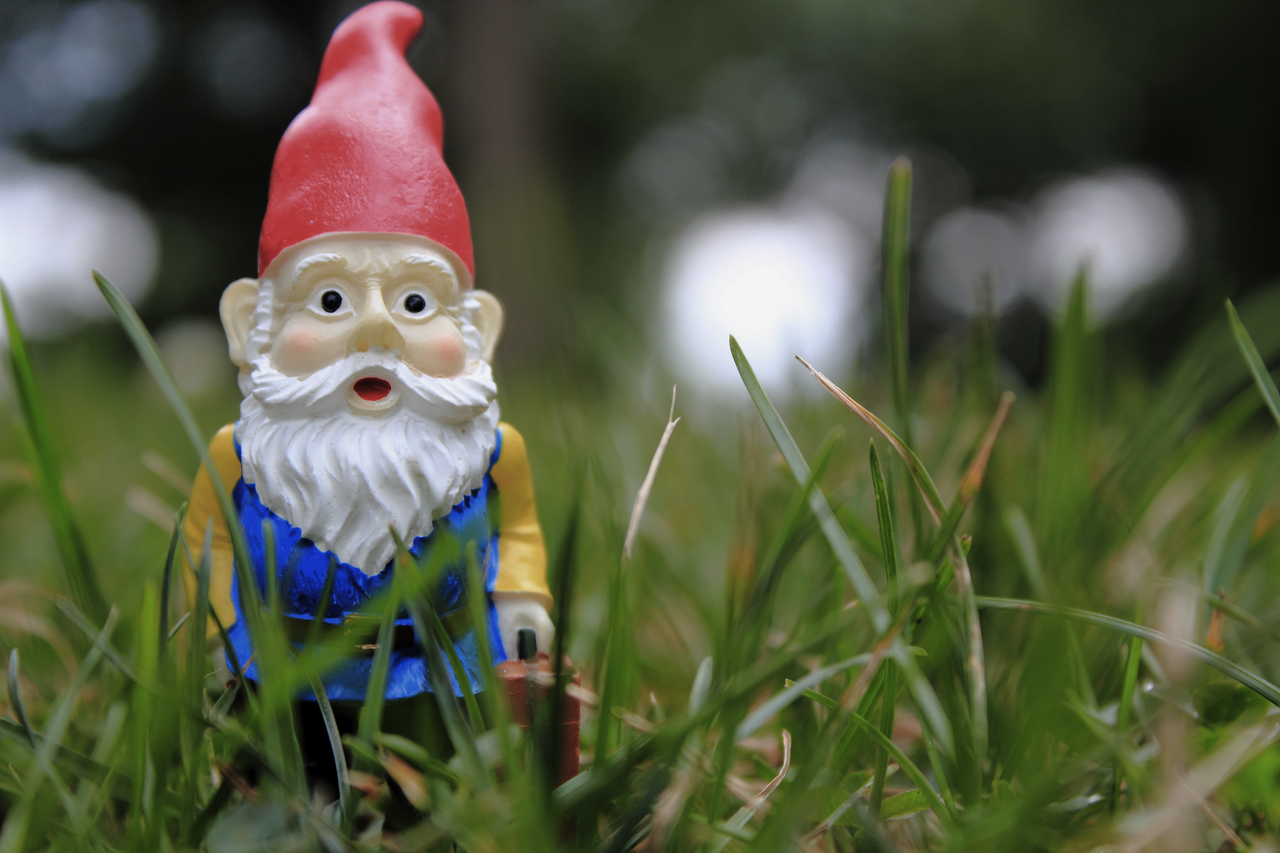This will probably be the last of these little classic fantasy RPG race rundowns for a while, as I am having a hard time in scraping together enough original ideas regarding dwarves and halflings to merit their own posts. Anyway this particular post concerns itself with GNOMES, the absurd little fairy men that so often go overlooked. Not without reason however - I'm not particularly fond of the portrayal of gnomes in most fantasy games myself. Next to stubborn dwarves, sombre elves, ambitious men and brutal orcs a whimsical race of tinkerers sticks out like a sore thumb. This is likely because gnomes have no basis in Tolkien while most of the other races are drawn nearly whole-cloth from his work. Some people think this reliance on Tolkien is a bad thing, and I used to be one of those people. But that's a an entirely different discussion, and I have pointy hatted men to talk about.
Regardless of their inherent dissociation from the tone of a typical fantasy RPG, some people like to play gnomes (and its always good to have more small sized PCs... heheh...) so it seemed unfair to simply remove them from my nascent setting without at least attempting to make them interesting. With this in mind, I took an aspect of gnomes I did like - their connection to faeries, or fey - and ran with it until my legs gave out.
 |
| A terrifyingly alien consciousness inhabits this little chunk of ceramic |
To fey, the planes of existence inhabited by humans and other 'mundane' creatures are as hostile to them as a plane made entirely of fire is to a paper crane. This analogy is somewhat misleading however - It's not a matter of the physical components of the material world being actively dangerous to fey so much as its contents are mentally toxic. Planes inhabited by fey are constantly shifting explosions of noise, light, smells and more esoteric stimuli typically only visible to the fey themselves.
Compared to this cavalcade of stimulation, the material planes are like extreme sensory deprivation chambers - the sheer
emptiness of the material plane is enough to drive them completely mad, and often one of the first things to slip through the widening cracks in their psyche is how to return home. When it is considered that most fey are nearly as old as the worlds they inhabit and have likely spent their entire lives there, its surprising the shock doesn't just kill them outright.
 |
| Like this, but the angle never changes, you can't move your eyes, and you will likely never die |
This begs the question then, why even attempt to enter the material world? Well all faeries, for reasons unknown, feel a constant powerful desire to meddle in the lives of mundane creatures. This urge unfortunately could not be sated through the notoriously unreliable methods of interplanar communication. So to achieve their noble goals of curdling milk, hiding keys and stealing babies some method of getting fey into the material world and keeping them sane had to be devised. This is where the gnomes come in.
 |
This guy's speciality is chewing on your toothbrush while you're asleep.
He doesn't know why he does it either. |
No one is sure whether they were altered from some ancient proto-gnome or fabricated entirely, but regardless of their origin they were the first 'vehicles' of the fey, and allowed them to spread their meddling tendrils through much of the material world. The gnomes' usefulness as vehicles stemmed from their unique neural architecture.
To a gnome, the intensity of any stimuli is amplified nearly ten times in an attempt to reproduce the vibrant madness of the fey planes. This prevented the gnome's 'pilot' from being driven insane, but this amplification was not quite enough to enable permanent residence on the material plane. Fey pilots were frequently swapped out to prevent excess mental strain, and the gnome mind was engineered to make this process as smooth as possible. The first gnomes possessed a 'neural net' similar to that used by
wizards to hold spells, allowing the fey to not only see through the eyes of their creations, but directly control their actions.
The process of exchanging pilots was not perfect however, and occasionally a gnome would be left without a fairy to control it. Early gnomes were about as intelligent as toddlers without fey influence, and were often left to their own devices until the next pilot slotted in. Though these periods of freedom were brief, eventually some gnomes ended up breeding outside the supervision of their controllers. Gnomes proved to be much more fecund than the fey expected, and soon there were far more vehicles than pilots. Small communities of free gnomes went feral, multiplying rapidly and often dying just as quickly.
 |
| Alas, the world is too cruel for one so innocent... |
A few 'true' gnomes remained in the service of the fey - growing
fairy rings, confusing travelers, cavorting and howling in the moonlight - but they are exceedingly rare, and considered urban legends by modern gnomes. The fey for the most part discarded the gnomes as a failed experiment, and were eventually able to craft more suitable, permanent, and most importantly
sterile vehicles in the form of satyrs and gremlins.
Meanwhile in the feral communities, the massive energy demand and intelligence suppression required by the neural contortions that house a fey pilot resulted in it quickly being removed from the budding communities through natural selection. The relatively benign sensory amplification, on the other hand, remained relatively intact. This amplification of stimuli is typically cited as the cause of the 'obsessions' commonly seen in modern gnomes, especially when that obsession involves creating something - both a complex mechanism and a simple clay pot can hold incredible sensory appeal to a gnome.
 |
"Magnificent!"
-Every gnome |
Unfortunately, this also results in gnomes being incredibly susceptible to even the mildest of addicting substances and activities. Most notably, many modern gnomes have taken to smoking copious amounts of nutmeg, being intoxicated not only by its somewhat toxic narcotic properties, but the simple fact that it has a very powerful aroma. Other strong sensations gnomes have been known to become hopelessly addicted to include staring at fractals/fields of flowers, rubbing their hands on bricks and obnoxiously loud humming.
 |
| Gravity Falls helpfully provides a sobering depiction of gnome drug abuse |
Don't let this apparent absurdity fool you, however - The sensory amplification also grants gnomes the ability to detect illusions along with supernaturally keen senses. Though not nearly as much as elves, their fey heritage makes them predisposed to the use of magic, and their interest in mechanisms and creation makes them valuable as craftsmen.









